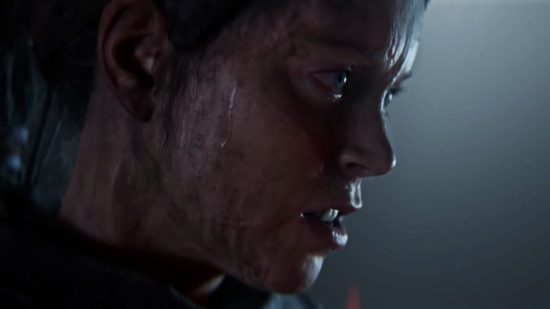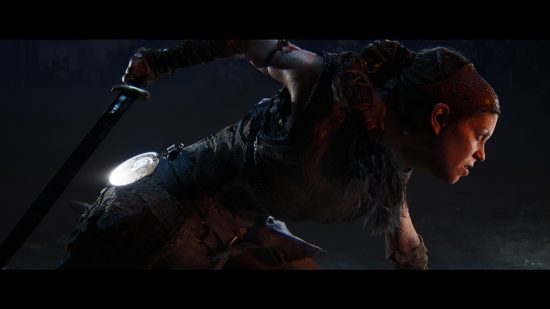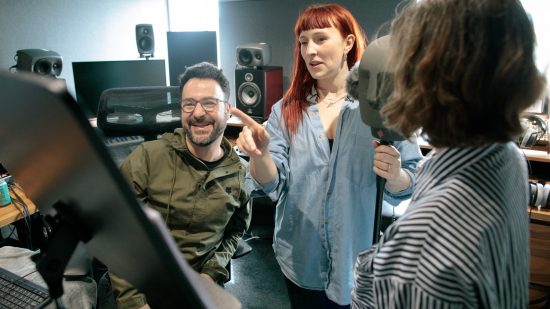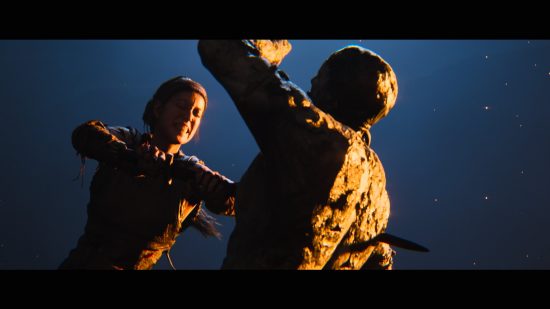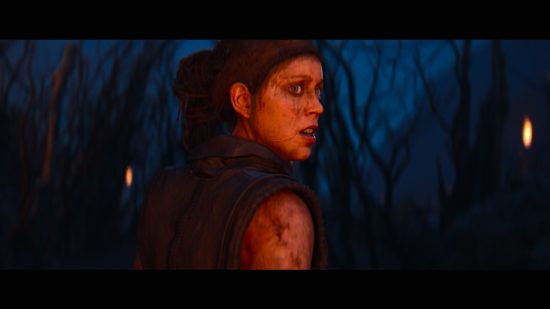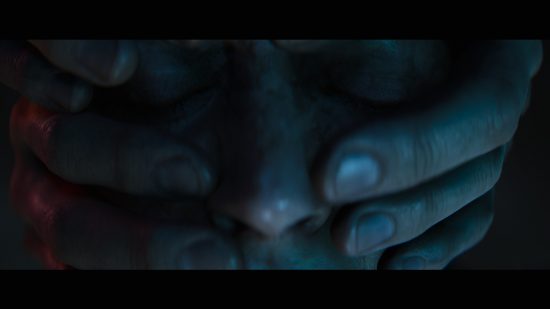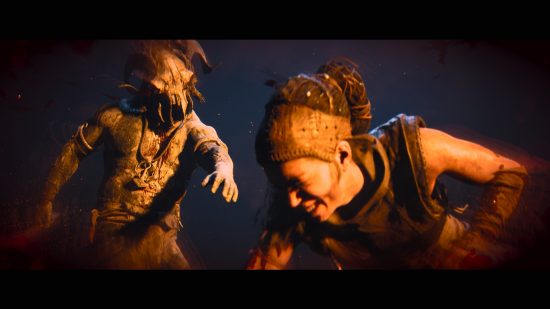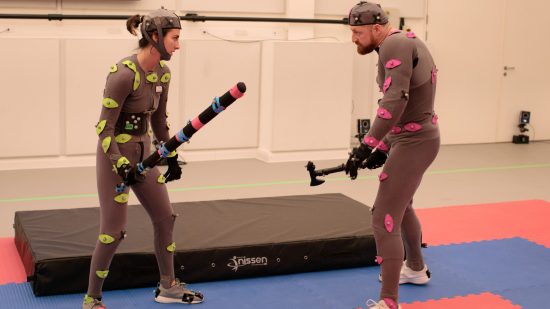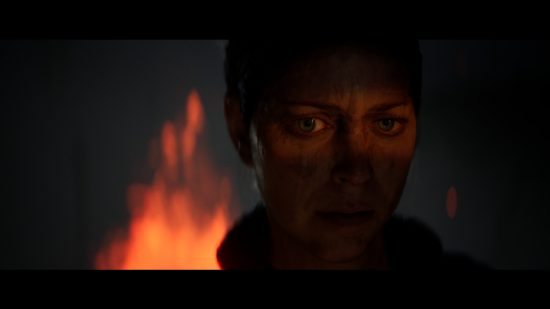“This is where my story began, and so it has to end here, because I cannot see further than this.” These are the final lines of Hellblade: Senua’s Sacrifice, delivered by Senua herself in a fourth-wall break that sees actress Melina Juergens turn her plaintive gaze to the camera. Developer Ninja Theory doesn’t share the sentiment. For half a decade, the studio has been hard at work on the next chapter – appropriately named Senua’s Saga – and I was invited to Ninja Theory HQ for a peek behind the curtain and a hands-on preview of Hellblade 2 in the final weeks of its development.
When I step into the reception area, I come face to face with a collection of beaming BAFTA masks, in pride of place on the shelf opposite the front desk. In the boardroom, the angelic countenance of two TGA statuettes wink from a cabinet at the far end of the room. From accolades to canvas prints, Senua’s legacy has seeped into the fabric of the building itself. It’s no surprise, then, that there’s a frisson of nerves running underneath the studio-wide excitement for Hellblade 2’s first hands-on preview. It also explains the meticulous schedule of the event itself, which aligns closer to a studio tour than any traditional preview event.
The preview is split into two parts defined by their location: Reykjanestá and Freyslaug. So much of Senua’s Sacrifice is spent suspended out of time and space, but Senua’s Saga is distinct on both counts. Studio head Dom Matthews describes it as a “love letter to Iceland,” delivered via an anamorphic cinema lens primed for photo mode. In the studio’s effort to fully capture Iceland’s topography, elevation data was quickly deemed sufficient, prompting on-location visits to acquire drone scans for photogrammetry. When I ask art director Dan Attwell why it had to be Iceland, the answer is simple: “It’s otherworldly. It’s like a geological theme park almost, there’s so much diversity in it.” In the wake of such extreme geological contrast, the psychology of Iceland’s landscape is a close match for Senua’s own.
The rocky shores of Reykjanestá are the stage for a short sequence to ease me back into the Hellblade experience after so many years. “[Senua] spent the first game being buffeted and overcome by her experiences, and she manages to arrive at a place of relative peace and acceptance,” Derham explains. “She’s in a place now where, instead of it being such an internal journey, she’s able to push out into the world and into the future a little more than she could have before.” The dull roar of the Icelandic sea sets a primordial tone that echoes the opening moments of Senua’s Sacrifice, a throughline that connects the pitch and keel of the binaural voices of the Furies, distant shouting, and the agonal choking of helpless victims dying around Senua. “It’s your fault,” the Furies hiss, and it’s the first clear suggestion of the shift towards that exteriority.
I also get a taste of the Furies in action in an audio demo that sees voice actors Abbi Greenland and Helen Goalan reprise their non-corporeal yet omnipresent roles from Senua’s Saga, swooping around a binaural dummy head sporting a set of fluffy microphones attached to each ear. This dance is set to a loose script that’s subject to improvisation, bolstered by the physicality that Greenland and Goalan inject into their movements. Without the visual stimulus of Senua’s journey, it’s more apparent that their accompaniment mirrors the tension and release of musical cadence, as they shift seamlessly through frantic whispers, stuttered fricatives, and deep-throated despair. Composer David Garcia Diaz compares their performance to jazz, in which the happy accidents that emerge through improvisation lend the Furies a “prismatic” quality that mirrors the unpredictability of psychosis.
Back to Reykjanestá. I take in the crashing waves, the intricate detail of a ship smashed to bits on the shoreline, then brace myself as a Northman stumbles out of the sea mist. He advances on Senua, a tower of corded muscle that grows taller as the camera pulls in close to meet him, and while my instinct is to step back, I instead step forward and parry his first swing effortlessly. This ease is partly thanks to Hellblade 2’s control scheme, which remains faithful to the lightweight mechanics of its predecessor. Light and heavy attacks are punctuated by dodges and parries, but the impact of each blow has far more weight and precision this time around. I eventually throw the Northman off-balance, exploit this opening to cut him down where he stands via a brutal finisher, and Reykjanestá fades to black.
The second sequence finds Senua in Freyslaug – what I assume to be the Fosslaug hot spring in modern-day Iceland, albeit in Hellblade 2, a ruined settlement occupies the landscape. It’s also here that we see Senua interact with other people, though the man in question is tied to a wooden post and he’s not very happy about it. “What does it look like and feel like when someone with a very strong unique world model comes into contact with other people with their own model of the world?” Matthews asks, then points to the infamous blue-and-black (or is it white-and-gold?) dress that was the subject of fierce online debate in 2015. “I went around the studio and asked, ‘What color is it?’ When people were wrong, and you told them that they were wrong, they actually got angry, because it challenged their model of the world.”
In this case, the man denounces Senua as a “crazy witch”, and the Furies drown out any further dialogue as Senua wrestles with her rage and the rising impulse to kill him. Naturally, this was a deliberate choice. “She’s having conversations internally with the Furies while also trying to have a conversation with another person,” Matthews explains. “For people who do experience psychosis, it is a daily struggle to try and manage that.” While I typically rely on subtitles for auditory processing, I find the tumultuity of this moment so striking that it’s enough to make me refrain from turning them on; after all, Senua doesn’t have subtitles to help her navigate these moments.
After taking petty revenge in a not-so-harmless tap on the man’s maimed leg, Senua turns her back on him and towards what remains of Freyslaug. While there’s an overall linear path through the settlement itself, I’m also free to pick through the desiccated remains of each residence, and the sound shifts to react to Senua processing what she sees. “The dense experience of family and settlement life that you get from the Sagas was one of the ways in which we approached how to depict the settlements,” scriptwriter Lara Derham reveals. In the case of Freyslaug, these remnants of family life serve to elevate the horror of its destruction. The echo of screams aligns with the glistening entrails of human remains, while the frantic whispers of a mother trying to hush her baby accompany the sight of an empty cradle.
A mutilated body strung up in ritualistic sacrifice at the head of a wooden bridge brings Senua to a standstill, and as she struggles to process what’s in front of her, a kaleidoscopic portal of whirling limbs, torsos, and faces blocks the path forward. Just like its predecessor, Senua’s Saga employs pareidolia as the crux of its puzzles – a form of pattern recognition that picks out connections in disparate shapes where none exist. As I pick my way through the settlement, runes swim across the screen, prompting me to find a matching shape somewhere in the environment. These puzzles were my least favorite part of Senua’s Sacrifice; not only am I exceedingly bad at them, but I find them fairly reductive as a representation of psychosis. That said, the sensory experience of this puzzle entirely surpasses those that appear in Senua’s Sacrifice, and the longer I spend trying to find what I’m looking for, the further I’m submerged into the near-hypnotic, cacophonic soundscape.
“Audio plays a massive role,” VFX director Mark Slater Tunstill says. “We often say that the Furies are kind of our HUD in a way.” However, there are plenty of visual signposts – such as light, geological formations, and yes, a smear of white paint – that also help to subconsciously guide me through both the puzzle-solving and general exploration of Freyslaug. Here, too, pareidolia plays a part, as a human face materializes on a lump of rock barring one residence then fades away to reveal a new path. “We made it really hard for ourselves, right?” Slater Tunstill laughs. “We’ve gone super realistic, but we’ve also gone no HUD, no camera cuts.” However, Attwell expresses trust in Hellblade’s older audience: “It’s people who want something different, want something immersive, and want something that’s shorter but more involved and enriching. So there’s a level of understanding that we’re expecting from them as well.”
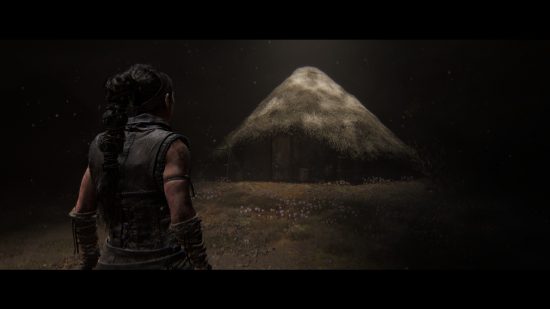
That trust appears well-founded as I locate each rune with minimal fuss, and the grisly tableau on the bridge transforms into the haunting image of Dillion at the site of Senua’s trauma: suspended, blood-eagled, in a web of rope as sunshine blazes behind him. In this liminal mindscape, Senua is once again tormented by the guttural facsimile of her father’s voice, until the Furies deliver a devastating realization: she cannot run from her torment; she’s forced to carry it with her wherever she goes. It’s a poignant yet devastating scene, and while the surreal image of disembodied hands slowly closing over Senua’s face is arresting, there’s no question that Juergens’ performance remains the driving force. Even here, in the depths of her trauma, there is a glimmer of the love Senua has for Dillion, and it is at this point that I tried very hard not to cry at a preview event.
Instead of consuming Senua, the darkness falls away into an idyllic representation of her childhood home, crystallized in her memory in verdant green and banked by flowers. Within, Senua retrieves the iron mirror she uses to slow time and stun enemies. I brace myself for a redux of the dissociative episode in Senua’s Sacrifice, where Senua gazes into the same mirror and speaks with the distorted voice of her father as she teeters at the precipice of suicide. This time, anchored in this memory of her mother, we just see Senua’s reflection. Professor Paul Fletcher, who returns as Ninja Theory’s mental health advisor for Hellblade 2, recalls conversations with people who have lived experience of psychosis on the nature of recovery. “It’s not about the voices suddenly disappearing or the past being blotted out,” Professor Fletcher explains. “It’s much more about achieving a new meaning and purpose for the future.”
That purpose becomes clear when I step back out of Senua’s mindscape, cross the bridge, and stumble upon the Northmen slaughtering the final remnants of the settlement’s population. Among the chaos, Senua spies a man tied to a post, struggling to escape, and she resolves to rescue him. As I move through the Northman’s camp, throat-singing wends its way through that familiar Hellblade soundscape as the Furies beg me to turn back. The firelight casts long shadows of villagers being butchered, leaving Senua’s imagination to run wild and transform the Northmen into mythical draugr. “What we’re depicting is the world that Senua sees, and we’re not really interested in the objective reality behind that because it almost doesn’t matter,” Derham asserts. “[Senua] is Pictish but the Norse imposed their own kind of mythology on her and it’s become a source of horror to her.”
Fundamentally, the Northmen are human – flesh, not fantasy – but their animal bone masks conceal that humanity for the player as much as Senua herself. It’s clear that Ninja Theory understands that painting yet another portrait of Senua’s psychosis for Hellblade 2 would be reductive and has instead positioned it to highlight the inherent subjectivity of reality beyond pathology. Professor Fletcher describes this as an “unshared reality,” and while this doesn’t come at the cost of Senua as a representation for those with lived experiences, the collision of cultures as a challenge to our understanding of the world is a universal experience that spans all of human history.
As the Northmen descend upon Senua, I’m as intimidated as I am curious how Ninja Theory expects me to overcome this challenge. It’s fair to say that combat is the weakest aspect of Senua’s Sacrifice, so it’s no surprise that Ninja Theory has gone to great lengths to revise it for the sequel. However, unlike Senua’s Sacrifice, Hellblade 2’s combat consists entirely of one-on-one battles where enemies come to Senua rather than the other way around. It would be easy for this to feel like an endless procession of enemies, but careful staging positions each skirmish as its own set piece rather than traditional third-person combat.
Combat director Benoit Macon cites Game of Thrones’ Battle of the Bastards as a major source of inspiration – specifically, the close-quarters clash of bodies and steel after the two armies meet. As Senua, I dance under a draugr’s blade before cutting him down where he stands with brutal efficiency, but there’s no time to celebrate; instead, a draugr’s hand shoots into frame and yanks Senua back by the shoulder to initiate a new skirmish. My attempts to block and parry are also interrupted by freed prisoners taking the chance to throw themselves into the fray alongside Senua – though they inevitably come to a swift and gruesome end in the process.
The rhythm of combat is a dance that quickly descends into the visceral movement of Senua hacking wildly at her foes. It’s a strenuous activity for these digital bodies, a weight made possible thanks to Ninja Theory’s light and airy mocap stage, with ceilings high enough to swing both swords and people. I’m afforded a glimpse of two Lucky 13 Action stunt coordinators going head to head in this space: one representing Senua, another a Northman. Their lightning-quick pace means that no take is ever the same, though the capture directors are mindful of body language, vocalization, and even breathwork. Hellblade 2’s cameraman dances around each performance with a handheld virtual camera, just about managing to keep up as ‘Senua’ is lifted into the air and tossed onto a nearby crash mat. I’m told there have been over 60 of these eight-hour mocap sessions throughout production; it’s a far cry from the two days spent in the repurposed boardroom full of IKEA wardrobes for the development of Senua’s Sacrifice.
Given the wealth of cinematic technology at the studio’s disposal, I ask Matthews why it remains important that Senua is still, ultimately, a videogame. “In film and literature, you’re a spectator, you’re watching someone else’s experience,” Matthews says. “We’re inviting players to step into the shoes of Senua and experience the world as she does. It just wouldn’t be possible in linear media.” I liken it to the difference between sympathy and empathy, and Matthews agrees. “I think it is an edge that games have: that ability to inhabit that world with that character in a way that film can’t allow you to do.” That immediacy becomes palpable as the tide of this bloody battle begins to turn in my favor. “Yes! Yes!” the Furies clamor, and there’s a shift away from the helplessness of Senua’s Sacrifice to the strength and fury that belies a hero in an Icelandic Saga.
All told, my hands-on time with Senua’s Saga could only have lasted 45 minutes at most, but the sensory experience lingered throughout the rest of the day. This is undoubtedly thanks to Ninja Theory’s unwavering commitment to realism across all elements of game development. “I think that realism for realism’s sake is kind of pointless,” Matthews maintains. “Realism for the sake of immersing people and being able to take them on a journey is what we’re striving to do.” There’s no better representation of that immersion than the moment I leave Freyslaug behind, sit back in my chair, and let out the breath I’d been holding for three-quarters of an hour.
Throughout all my conversations at Ninja Theory HQ, it’s clear that every creative decision for Hellblade 2 – from costume to combat to environmental design – is filtered through a single question: “Is it in service to the narrative?” Aside from a few breadcrumbs scattered through dialogue and those same conversations, the scale of that narrative is still unknown, though this hands-on preview has left me with a clear understanding of just how far Ninja Theory is willing to go to realize it. As Senua says in those final moments of Senua’s Sacrifice, this will now be our story to witness – in just a few more weeks.
